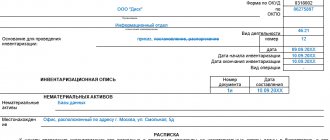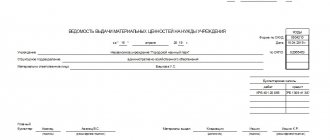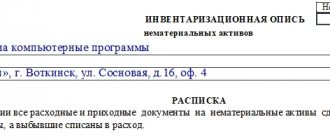Why do you need an inventory report?
The state obliges enterprises to regularly conduct an inventory of assets and liabilities - this is enshrined in Art. 11 Federal Law No. 402 “On Accounting”. However, the law does not provide for penalties for non-compliance. Therefore, some individual entrepreneurs and organizations do not pay due attention to inventory. But in vain! The event allows you to find out how many goods you have, what condition they are in, and whether there are any losses.
An inventory report is needed to control inventory, cash, intangible assets, as well as debts to counterparties or creditors. With the help of a check, you can find out whether the actual presence of valuables corresponds to the quantity recorded in the accounting documents.
The procedure for reflecting inventory results in accounting
In accordance with paragraph 1 of Article 12 of the Accounting Law, in order to ensure the reliability of accounting data and financial statements, organizations are required to conduct an inventory of property and liabilities, during which their presence, condition and valuation are checked and documented.
The procedure and timing of the inventory are determined by the head of the organization, except for cases when the inventory is mandatory.
According to paragraph 2 of Article 12 of the Accounting Law, inventory is mandatory in the following cases:
- when transferring property for rent, redemption, sale, as well as during the transformation of a state or municipal unitary enterprise;
- before preparing annual financial statements;
- when changing financially responsible persons;
- when facts of theft, abuse or damage to property are revealed;
- in the event of a natural disaster, fire or other emergency situations caused by extreme conditions;
- during reorganization or liquidation of the organization;
- in other cases provided for by the legislation of the Russian Federation.
Where and when is it used?
In fact, an inventory act is needed by all business entities: large, medium and small businesses. There are practically no differences in the preparation of the report. The only difference is in the forms (IVN) and the scale of inspections. For example, in the same store, reports can be compiled on weekends or during lunch breaks - within a couple of hours. In a large enterprise, the verification may take a whole night.
Inventory can be voluntary or mandatory. In the first case, an order from the director or head of the enterprise is sufficient.
In the second case, it is necessary to take into account the circumstances of such verification:
- Change of financially responsible person, for example - the arrival of a new warehouse manager;
- Suspicions of theft or theft;
- Force majeure situations and disasters (flooding, fire, destruction);
- Liquidation or reorganization of production;
- Annual report of the organization on the results of its activities.
The head of any company can initiate a review of tangible/intangible assets and obligations at any time.
How to fill out an act using the INV-1 form
- At the top of the document you must indicate the name of the organization, the number of the structural unit and the name of the document that became the basis for the inventory.
- There is a small table in the upper right corner of the INV-1 form. It must indicate the following: OKPO code, type of activity code, number and date of preparation of the basis document, start date of the inventory and its end.
- Below you need to write down the number of the act and the date of its preparation.
- After this, you must indicate the name of the OS, what rights the organization has them (ownership or custody), and the location of the assets. If the fixed assets are leased, the name of the lessor company is indicated in the act.
The next section is called “Receipt”. Here the financially responsible person must sign with a transcript. By this, it confirms the fact that by the beginning of the audit, all received fixed assets were capitalized, the dislodged assets were written off as expenses, and expenditure and receipt documentation was submitted to the accounting department.
Below is a table in which the responsible person must enter data on the results of the inventory:
- OS name;
- name and details of the document confirming acceptance of the OS for safekeeping (rent);
- year of asset release (or construction);
- inventory and serial number, passport number (registration document);
- actual availability (quantity and cost);
- quantity according to accounting data.
Under the table you must indicate the total number of fixed assets and their total cost. The form for the inventory of fixed assets is signed by the chairman and members of the commission that conducted the inspection. It must also be signed by the chief accountant.
Read also: OS inventory: postings
Compiled by whom?
One person is not involved in drawing up the inventory report. A commission of at least 3 people is always appointed. The director or head of the company must indicate who will be among them in the issued order.
Typically the commission includes:
- Head of the enterprise;
- Accountant;
- Responsible for storing inventory and intangible assets;
- Professional auditors (optional);
- Employees of the organization.
This means that the act must contain the full names and signatures of all participants in the inventory. Members of the commission have the right to make written comments and clarifications. A mandatory condition is also the personal presence of the persons noted in the manager’s order. If someone is not present, as well as someone’s signature is not on the act, the event cannot be considered completed. And the report data may be considered invalid.
If there is a break in the work of the commission, it is necessary to limit access to documentation. It is usually placed in a safe or locker for safekeeping. An office or store premises may be sealed during a break (for example, at night). Outsiders should not have access to the results of the audit to avoid falsification of information.
Features of the formation of the inventory commission
The head of the company must issue an order to carry out measures to control and record fixed assets. The same document should list the members of the inventory commission. It can include an accountant, economist, warehouse manager and other administration representatives. All members of the commission must carry out the inventory in full; if at least one of them is absent at this time, the results of the inspection will be considered invalid.
It is very important that the verification of the actual availability of OS is carried out in the presence of the financially responsible employee, since his explanations may be required during the event.
Sample Fixed Asset Inventory Act
How to draw up an inventory report?
Before the inspection, you need to select the form of the act and establish the exact composition of the commission. Next comes only calculations and comparisons.
Form
The act is drawn up strictly in writing. Usually they use a ready-made electronic form in *xlm format. All you need to do is enter the required values into Excel and it will produce a sample for printing. It is also possible to fill out the A4 sheet by hand.
The form of the act on the results of the inventory depends on the type of valuables. There is no universal and unified template for all assets and liabilities of the company - by virtue of clause 1.2 of Resolution of the State Statistics Committee No. 88 of August 18, 1998.
For example, if you need to calculate fixed assets, the INV-1 act form is used. For intangible assets (trademark, licenses), form INV-1a should be prepared. Goods are entered into the INV-3 form, and precious metals into the INV-8 form. Even for debts and obligations of the company, a separate form is provided - IVN-17.
If the situation requires it, responsible persons can make new items or changes to the unified form. In this case, it is prohibited to delete document details (but you can add new lines in the form).
Content
The selected form must be filled out:
- “Document header” – name of the organization, OKUD and OKPO codes, start and end dates of the inventory process, as well as details of the basis document (order, resolution or regulation), details of the order on its appointment and the period of the inventory;
- The main part is to note the type of assets (inventory, cash, precious metals, accounts receivable), their location (office, warehouse, workshop), quantity or cost;
- Full name of financially responsible persons, for example, chief accountant, warehouse manager, etc.
- Inventory results;
- Full names and positions of commission members + signatures with their transcripts;
- Date and year of the event.
The report on the results of the inspection is drawn up in 2 copies - both are certified by an expert commission. One will go to the accounting records, and the second will remain with the financially responsible person. Subsequently, it will be possible to raise the verification data at any time.
Documentation of inspection results
In the process of checking the actual existence of objects (obligations), control documents are drawn up, which differ depending on the object. The organization has the right to independently develop forms of control documents or use standardized forms approved by Resolution 88 of the State Statistics Committee.
The results are presented:
- inventory records, which reflect the actual availability and quantity;
- matching statements, where discrepancies between fact and accounting data are indicated.
Control of inventory, fixed assets and cash
You can download a sample act of inventory of shipped inventory items and a sample act of inventory of fixed assets (unfinished repairs) at the end of the article.
It is recommended to inventory cash more often in case of significant movement of funds. To do this, use the form for checking funds at the cash desk.
- The cash register inventory report can be found in the appendix to the article. There is also a sample of filling out a cash inventory report.
Debt control
Verification of obligations is carried out to determine current, overdue debt, debt that is unrealistic for collection, among:
- buyers and suppliers;
- creditors (debtors) and other persons.
The results are documented in writing - see Sample of an inventory report of receivables and payables.
More information about the unrealistic debt of liquidated counterparties, as well as debt for which the statute of limitations has expired, can be read >in the response of the Ministry of Finance.
Control of intangible assets
Occurs with the registration of INV 1-a form. If discrepancies are identified based on the results of the audit, a comparison sheet INV-18 is drawn up.
Completion
To record the results of control checks on the correctness of monitoring, a report on the results is drawn up. To find out the rules for filling it out, see Sample of filling out an act on inventory results.
Inventory order
Inventory report of shipped inventory items
Inventory report of fixed assets (unfinished repairs)
Cash inventory report (form)
Cash inventory report (filling sample)
Inventory report of receivables and payables
Form INV 1-a
Form INV-18
Statement of results (form)
Required documents
The drawn up act will not have legal force without the accompanying documents:
- order, resolution or order to conduct an inventory at the facility;
- inventory - with details for each item of inventory, intangible assets, cash or liabilities;
- comparison sheet - an appendix to the act where surpluses or shortages during the inventory are recorded.
In this way, a general package of documents is formed, which reflects the results of the company’s inventory.
Why do we need an inventory of property (including those proposed for write-off)?
- inventory report of shipped goods and materials (INV-4 form);
- act of inventory of precious stones and metals (forms INV-8, INV-9);
- act of inventory of funds (form INV-15).
The act may reflect:
- establishing shortages and surpluses for certain accounting items;
- performance by the inventory commission of actions aimed at offset (in case of misgrading), writing off shortages (to the guilty party, to other expenses);
- circumstances of identifying the guilty persons (in case of shortage, mis-grading).
In some cases, the act complements the inventory records. For example, a separate inventory report of the property proposed for write-off may be drawn up. As an option, in the TORG-16 form (used at commercial enterprises).
In budgetary organizations, form 0504835 of the act on the results of inventory is used. Many private firms use its direct analogs (or it without changes, having approved the procedure for using the form in their accounting policies).
Let's take a closer look at the specifics of filling out the universal form 0504835, used by both budgetary enterprises and private firms, and get acquainted with a sample act based on the results of an inventory of the assets of a business entity.
Where can I download an order based on inventory results for free?
Inventory is done for all property on and off the balance sheet of the enterprise. The obligation to carry out an audit annually is specified in the Law “On Accounting” dated December 6, 2011 No. 402-FZ.
Subscribe to our newsletter
Yandex.Zen VKontakte Telegram
Inventory is carried out in order to verify the presence of values, obligations and the reliability of their reflection in accounting. It allows you to identify the state of fixed assets, intangible assets, inventories, inventory, cash and other assets, as well as analyze the financial position of the company. Based on its results, a deviation of the actual data from the accounting indicators can be identified, on the basis of which an order based on the results of the inventory is drawn up; a sample of it can be downloaded for free on our website.
In this case:
- Damaged property discovered after inspection is written off or sent for repairs;
- in the event of a shortage of property, the perpetrators are identified;
- discrepancies in the obligations of accounts receivable and accounts payable are verified by reconciliation reports;
- Based on the results of the inventory, a commission is appointed that proposes methods for eliminating inaccuracies;
- based on the results of the commission meeting, a protocol is drawn up, as well as a statement of results in free form or in the form INV-26, approved by Resolution of the State Statistics Committee of the Russian Federation dated August 18, 1998 No. 88;
- details and data of the order, the result of control measures are displayed in the order monitoring log (INV-23);
- Based on the results of the review, a final decision is made - an order to approve the inventory (a sample of which is given in the article), drawn up based on the results of the audit of inventory items.
If the enterprise simultaneously carries out control measures in various areas, then there can be as many orders as there are inventories, or one general order can be drawn up covering all areas.
A volume audit can be partial, affecting only one obligation, for example, writing off accounts receivable. Then the order may reflect one point, for example: “Write off the receivables of Mechta LLC, listed on the balance sheet, due to the expiration of the statute of limitations and the completion of all methods for collecting the debt by October 30, 2020 (at the end of 5 years). Responsibility should be assigned to the chief accountant I.P. Nosova.”
Find out about writing off accounts receivable in tax accounting from the ready-made K+ solution. To get acquainted with all the nuances of this difficult procedure, get free online access.
How to fill out an order for approval of inventory results
Based on the results of the inventory, it is necessary to make a final decision, for which the head of the enterprise (or individual entrepreneur) issues an order approving the results of the inventory, a sample of which we will consider below.
You will find the answer to the question of how inventory is carried out during reorganization in consultation with an expert from the ConsultantPlus legal reference system. Sign up for a free trial and check out this and other great content.
The order displays the following information:
- name of the company or full name of the individual entrepreneur;
- date of preparation and serial number of the order;
- the location of the inventory (this can be the organization as a whole, a structural unit, a retail outlet, a warehouse, etc.);
- reason for inventory:
- planned (before drawing up annual reporting, in connection with the requirement of the company’s accounting policy for the reporting period);
- unscheduled (change of financially responsible persons, theft, sale of property, natural disaster or other reasons);
- control or repeated (in order to confirm the reliability of the control measures taken);
The order approving the inventory results is signed by the manager, as well as the chief accountant and all employees named in this order, for review purposes. All materials are transferred to the accounting department for execution. The order serves as the basis for recording the final results in accounting and at the same time helps the manager to monitor the implementation of all necessary activities. In case of non-compliance, a decision is made to punish the perpetrators.
There is no legally unified form for this order, so the form can be developed independently, taking into account the specifics of the company or individual entrepreneur and the specifics of the inventory. Each company has the right to approve the order template and make it mandatory for use. It can be issued on letterhead or a regular sheet of paper.
Registration of results and reflection on accounts in accounting and reporting
It is typical for law enforcement ministries and departments to carry out an inventory in accordance with departmental regulatory documents, for example, the Procedure for conducting an inventory of property and liabilities in the Armed Forces of the Russian Federation, approved by Order of the Russian Ministry of Defense dated October 16, 2010 N 1365.
Mandatory inventory is established by the legislation of the Russian Federation, federal and industry standards (clause 3 of article 11 of the Accounting Law).
Carrying out an inventory is mandatory:
- when transferring property for rent, redemption, sale, as well as during the transformation of a state or municipal unitary enterprise;
- before preparing annual financial statements;
- when changing financially responsible persons;
- when facts of theft, abuse or damage to property are revealed;
- in the event of a natural disaster, fire or other emergency situations caused by extreme conditions;
- during reorganization or liquidation of the organization.









